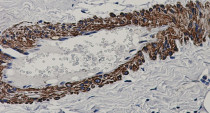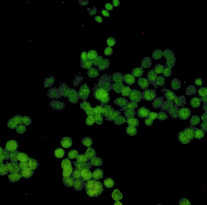ARG43701
anti-AP2 gamma antibody
anti-AP2 gamma antibody for ICC/IF,IHC-Formalin-fixed paraffin-embedded sections,Western blot and Human
Overview
| Product Description | Rabbit Polyclonal antibody recognizes AP2 gamma |
|---|---|
| Tested Reactivity | Hu |
| Tested Application | ICC/IF, IHC-P, WB |
| Host | Rabbit |
| Clonality | Polyclonal |
| Isotype | IgG |
| Target Name | AP2 gamma |
| Antigen Species | Human |
| Immunogen | Synthetic peptide corresponding to Human AP2 gamma. |
| Conjugation | Un-conjugated |
| Protein Full Name | Transcription factor AP-2 gamma |
| Alternate Names | ERF1; TFAP2G; hAP-2g; Transcription factor ERF-1; Transcription factor AP-2 gamma; AP2-GAMMA; Activating enhancer-binding protein 2 gamma; AP2-gamma |
Application Instructions
| Application Suggestion |
|
||||||||
|---|---|---|---|---|---|---|---|---|---|
| Application Note | * The dilutions indicate recommended starting dilutions and the optimal dilutions or concentrations should be determined by the scientist. | ||||||||
| Positive Control | HeLa | ||||||||
| Observed Size | ~50 kDa |
Properties
| Form | Liquid |
|---|---|
| Purification | Affinity purified. |
| Buffer | 50 mM Tris-Glycine (pH 7.4), 150 mM NaCl, 0.01% Sodium azide, 40% Glycerol and 0.05% BSA. |
| Preservative | 0.01% Sodium azide |
| Stabilizer | 40% Glycerol and 0.05% BSA |
| Concentration | Batch dependent |
| Storage Instruction | For continuous use, store undiluted antibody at 2-8°C for up to a week. For long-term storage, aliquot and store at -20°C or below. Storage in frost free freezers is not recommended. Avoid repeated freeze/thaw cycles. Suggest spin the vial prior to opening. The antibody solution should be gently mixed before use. |
| Note | For laboratory research only, not for drug, diagnostic or other use. |
Bioinformation
| Database Links | |
|---|---|
| Gene Symbol | TFAP2C |
| Gene Full Name | transcription factor AP-2 gamma (activating enhancer binding protein 2 gamma) |
| Background | The protein encoded by this gene is a sequence-specific DNA-binding transcription factor involved in the activation of several developmental genes. The encoded protein can act as either a homodimer or heterodimer with other family members and is induced during retinoic acid-mediated differentiation. It plays a role in the development of the eyes, face, body wall, limbs, and neural tube. [provided by RefSeq, Jul 2008] |
| Function | Sequence-specific DNA-binding protein that interacts with inducible viral and cellular enhancer elements to regulate transcription of selected genes. AP-2 factors bind to the consensus sequence 5'-GCCNNNGGC-3' and activate genes involved in a large spectrum of important biological functions including proper eye, face, body wall, limb and neural tube development. They also suppress a number of genes including MCAM/MUC18, C/EBP alpha and MYC. Involved in the MTA1-mediated epigenetic regulation of ESR1 expression in breast cancer. [UniProt] |
| Cellular Localization | Nucleus. |
| Calculated MW | 49 kDa |
| PTM | Sumoylated on Lys-10; which inhibits transcriptional activity. [UniProt] |
Images (3) Click the Picture to Zoom In
-
ARG43701 anti-AP2 gamma antibody IHC-P image
Immunohistochemistry: Formalin-fixed and paraffin-embedded Human breast cancer tissue stained with ARG43701 anti-AP2 gamma antibody at 1:100 dilution. Antigen Retrieval: Heat mediated was performed using sodium citrate buffer pH 6.0.
-
ARG43701 anti-AP2 gamma antibody WB image
Western blot: Hela cells stained with ARG43701 anti-AP2 gamma antibody at 1:1000 dilution.
-
ARG43701 anti-AP2 gamma antibody ICC/IF image
Immunofluorescence: 100% Methanol fixed (RT, 10 min) HeLa cells stained with ARG43701 anti-AP2 gamma antibody at 1:150 dilution.








